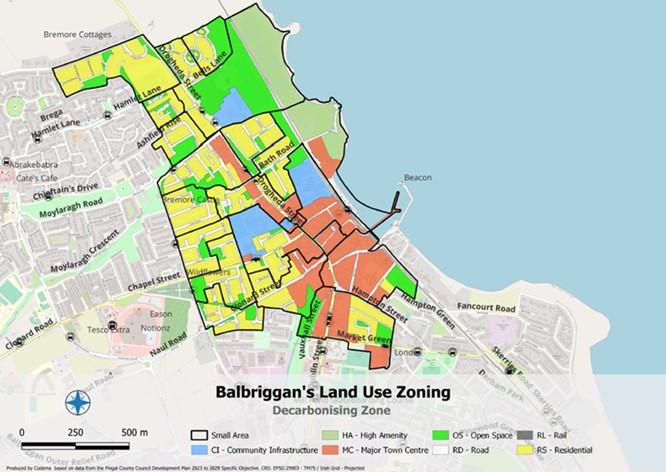Decarbonising Zone
What is a Decarbonising Zone?
A Decarbonising Zone (DZ) is a chosen area where local authorities and communities work together to reduce the amount of carbon produced by their everyday activities. By looking within the community for ways to live and work more sustainably, these zones can find local solutions to global problems, such as reducing greenhouse gas emissions, improving air quality, saving energy and reducing waste. The main objective of a Decarbonising Zone is to find innovative but achievable ways to reduce greenhouse gas emissions from the area by 51% by 2030, based on 2018 levels, in line with the National Climate Objective. Each zone’s plan will be based on the characteristics of the area, what is of benefit to the local community, and how these elements can work together to reduce or remove carbon and other greenhouse gases from the zone. By creating these zones nationwide, different approaches and projects can be tested and perfected, allowing other communities to apply these ideas based on their own needs.
Why is the Decarbonising Zone project Happening?
Under the National Climate Action Plan 2019, every local authority in the country is required to plan a Decarbonising Zone. Further to this, as part of the Climate Action and Low Carbon Development (Amendment) Act 2021, every local authority is also required to produce a detailed Climate Action Plan. The Guidelines for Local Authority Climate Action Plans published by the Department of the Environment, Climate and Communication (DECC) in 2023, clarified that Decarbonising Zones must now be included in all local authority Climate Action Plans.
Why was Balbriggan Chosen?
Balbriggan has been designated as a decarbonising zone by Fingal County Council. This means it's a specific area where efforts are focused on reducing carbon emissions through various local solutions. The focus includes initiatives like promoting active travel, retrofitting homes, and greening the area. Balbriggan is part of a broader effort by Fingal County Council to reduce greenhouse gas emissions and achieve climate neutrality by 2050
To qualify as Decarbonising Zones, the chosen areas need to have certain characteristics that have potential for climate action across a variety of sectors. Balbriggan was chosen as a Decarbonising Zone as it was considered;
- to be ready to support climate action,
- to have a strong sense of community,
- to be the right size in terms of population (at least 5,000 people for urban decarbonising zones).
As a Decarbonising Zone, Balbriggan also has a lot of potential for developing new and existing climate projects, with opportunities for tackling a host of issues. For example, air quality could be improved by looking at increasing use of public transport, active travel, and mobility hubs. Energy sustainability could be addressed with new energy infrastructure, like electricity network upgrades and district heating, and by improving efficiency and renewable heat in residential, public, and commercial sector buildings. There are opportunities for greening projects that support biodiversity in both public and privately held areas of land. Additionally, the Our Balbriggan project which aims to transform and rejuvenate Balbriggan by 2027 is currently underway with government funding of over €50m. Together, the Our Balbriggan project and decarbonising zone have the potential to be developed hand in hand, and make a greater positive impact for the area.
What are the next Steps?
The next step for the Balbriggan Decarbonising Zone, is to co-create a localised decarbonisation zone implementation plan, in consultation with the local community, and local stakeholders. This may include:
- Developing a local community and public engagement plan.
- Establishing a local stakeholder group made up of representatives from the local community, business, transport, energy sector, and others.
- Co-creating a list of prioritised actions, expanding on the register of opportunities outlined in this chapter. • Developing a governance framework for the decarbonising zone.
- Supporting the delivery of the implementation plan to achieve the decarbonising zone vision for 2030.
What is the role of Fingal County Council?
The core role of Fingal County Council in the Balbriggan Decarbonising Zone is as a facilitator. To support and deliver the Decarbonising Zone plan, action will be needed by Fingal County Council, but also other public sector organisations, local business and industry, social and community groups, and the wider public. Recognising this, Fingal County Council will play several roles while supporting climate action in Balbriggan. These roles are:
- Direct action delivering on climate action in areas within the local authority’s direct control including own buildings, infrastructure, systems, operations, and staff.
- Facilitation delivering on climate action by coordinating, connecting, and linking others. This can include stakeholder engagement, capacity-building, developing partnerships, funding, and policy support, among other enabling activities.
- Advocacy communicating, influencing, and building on a shared vision of the DZ, as well as raising awareness of the DZ plan and developing recommended and new actions with a wide network of local stakeholders to achieve support from the local community.

Related Documents
Fingal Climate Action Plan 2024-2029: Climate Action Plan 2024-2029 | Fingal County Council
E2-CUTIES webpage: E2-CUTIES | Fingal County Council